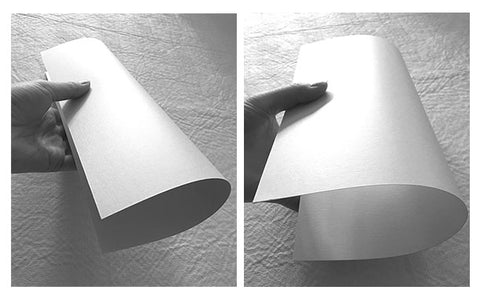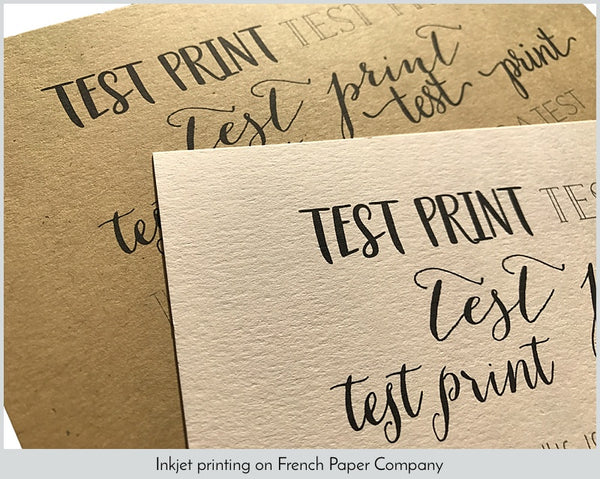Paper 101 - Printing On Cardstock
Whether you plan on DIY (do it yourself) printing or professional printing, carefully consider the printing information provided for the paper you are interested in using.
-
Not all paper weights and types are suitable for all printers, especially home printers.
It is important to take into consideration many factors when choosing paper for a print project, including but not limited to: paper weight, paper material and coatings, paper grain, moisture, heat, ink, speed, the printer’s paper path and printer settings. Not all printers can safely and successfully accommodate all types of paper.
What is paper "grain"?
Paper is made up of tiny grains of fiber that align in the same direction during the manufacturing process, much like a school of fish or a flock of migrating birds!
-
The many small fibers are pressed together.
-
The paper grain is the direction in which most of the paper fibers run.
-
Grain typically runs with the length of a rectangular sheet, which is known as long grain, but it can run along the width.
- Grain that runs across the width of the sheet is known as short grain.
-
Test the paper to find the grain by bending the paper part way, as if to fold it. Do this in each direction.
-
There is less resistance when the fold line runs with the grain.
With the grain vs. against the grain

What does this mean for printing?
Not all printers can print heavyweight cardstock. This can be further affected by paper grain. When a sheet of paper is fed into a printer and it's path goes around a roller, a long-grain paper will be more resistant to bending around the roller than a short-grain paper. So a short-grain paper may bend just enough to allow it to feed, while a long-grain paper may not feed or jam.
Tip - Having a manual single-sheet feed option that does not require the paper to roll during printing may resolve this problem. Manual feed is usually a special slot located in the front or back of the printer. Another trick is to carefully bend a small stack of the paper back and forth several times against the grain without creasing it. This may help to break-in and loosen the grain to reduce resistance and help it feed through the printer.
For DIY projects, start by consulting your printer manual and making sure your printer settings are adjusted for the type of paper you wish to use. Keep in mind that you may or may not be able to successfully print all paper types, or even the same types (with different grains), in any printer.
-
For professional printing, consult with your print shop and have them run test prints before purchasing a large amount of paper and ordering a print job. Do not assume that a professional or big box printer can print on any paper as they are also limited by the type of printing equipment they have available.
Tip - We strongly recommend that you test your paper(s) of choice prior to purchasing. We are more than happy to help you find the perfect paper for your project and help you throughout your design process, To help with testing, we offer paper samples of all of our paper products. Test print the paper in both directions to make sure it will print both long and short grain.
Printing Applications
Inkjet- Inkjet printers use tiny nozzles to spray ink onto the paper. This liquid ink will soak into the paper and may need some time to dry to avoid smudging. Inkjet is the most common form of home printer, and responds well to most paper types, but may not work, or work as well, on certain coated and reflective papers where ink is not readily absorbed and can easily smear and smudge. Inkjet printers are especially successful at printing on textured card stocks.

Laser- Laser printers use a toner cartridge filled with powder and heat to create a virtually waterproof, plastic-like ink that sits on top of the paper. (Flush with the paper. Words will not be raised.) Unlike inkjet ink, laser ink does not soak into the paper, so it is dry right away and allows for printing on some surfaces that inkjet cannot print on such as metallic, pearlescent, and reflective paper.

Inkjet vs. Laser- When viewed at an angle, you can see how the inkjet ink soaks into the paper, while the laser ink leaves a very thin plastic-like coating on top.

Letterpress- In letterpress printing, an inked metal plate with the raised text/design is mechanically pressed into the paper to create an impression in the paper. Letterpress is the oldest form of printing and is the height of luxury when it comes to paper goods. (Note that letterpress printing works best on papers 100# or higher.)

Thermography- In thermographic printing, powder ink and heat come together to create a raised, embossed finish. Thermography is commonly used on luxury paper items and works with almost all paper types.
Other Applications Include:
Lithography - Offset - Silkscreen - Embossing - Debossing - Laminating - Foil Stamping - Engraving - Die / Laser Cutting - Scoring and Folding
Printing Recommendations* by Paper Type
Matte papers are uncoated and offer a high-quality performance for laser and ink jet digital printers as well as copiers, provided the proper test runs have been made for paper thickness. Also suitable for Letterpress, Thermography, Lithography, Offset, Silk Screening, Embossing, Debossing, Laminating, Foil Stamping, Engraving, Die / Laser Cutting, Scoring and Folding.

SHOP MATTE COLLECTION SHOP NATURALS COLLECTION
Pearlescent papers are laser printer compatible. Although possible, inkjet printing is not recommended as print may smudge if the paper is too thick for the printer or is not allowed to dry before handling.
Also suitable for Letterpress, Thermography, Lithography, Offset, Silk Screening, Embossing, Debossing, Laminating, Foil Stamping, Engraving, Die / Laser Cutting, Scoring and Folding.

*NOTE: While some inkjet printers have successfully printed on Stardream, these printers are able to handle the thickness of the paper, print with a flat feed, and require special handling and significant drying time. In general, Inkjet on Stardream is not recommended.
SHOP STARDREAM PEARLESCENT COLLECTION
Mirror Foils are not suitable for inkjet printing but are compatible with many other printing application procedures including, but not limited to: laser, thermography, lithography, digital, silkscreen printing, offset printing, embossing, foil stamping, engraving, die or laser cutting, and folding and or scoring.
Wood Veneers can be printed using offset, digital, flexo, screen, flatbed inkjet and letterpress printing processes and can be die-cut, embossed, foiled, scored, folded, laser cut, laser etched, stapled and sewn just like paper.

*Disclaimer: The information on our website regarding printing and other applications is only a guide to best practice based on our experience, paper mill product specifications, and the expertise and testing of our paper professionals. Due to the many and varied types of personal and professional printing and paper finishing processes and inks on the market, we cannot guarantee that all products will perform as desired in regards to paper compatibility with printing and other applications.
Cardstock Warehouse Paper Company, Inc. shall not be liable, in any way, for incidental or consequential damages or losses sustained, or aggravated, by print or paper recommendations whether or not made verbally, or in writing on this website. Paper compatibility for desired outcomes is the sole and exclusive responsibility of the customer.


